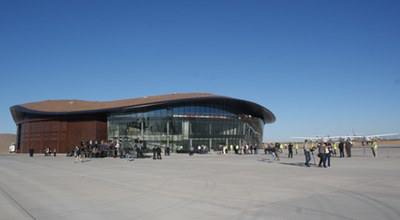A gateway to space emerges in the desertby Jeff Foust
|
| “There is no other company that is as close to flying people to space as Galactic,” claimed Whitesides. |
After the dancers and Branson’s children lowered themselves to the ground, Branson remained in place, dangling in midair and clutching a large bottle of champagne that had been lowered to him, to formally announce the name of the building. “And, the name is, whoa!” he said, exclaiming as he uncorked the bottle, “Virgin Galactic Galactic.” For six seconds he sprayed champagne on the crowd below before belatedly adding, “Gateway to Space.”
While the crowd laughed and cheered, some were left scratching their heads. “What did he say the name was?” one person in the media section asked. “Something about a gateway to space, I think,” said another. The building’s name, in fact, is now officially the “Virgin Galactic Gateway to Space.”
That was a minor glitch in an event that otherwise went smoothly, featuring a flight by Virgin’s WhiteKnightTwo (WK2) aircraft, carrying SpaceShipTwo (SS2), as well as a press conference inside the new hangar (albeit one that offered the assembled media no opportunity to ask questions). The crowd at the event included about 150 of Virgin Galactic’s future astronauts as well as others that spanned the gamut of celebrity from Buzz Aldrin to actress Kate Winslet to Britain’s Princess Beatrice. The event was designed to demonstrate the progress both Virgin and New Mexico had made on their spaceplane and spaceport, respectively, but also served as a reminder that their work, despite Monday’s celebration, is not yet done.
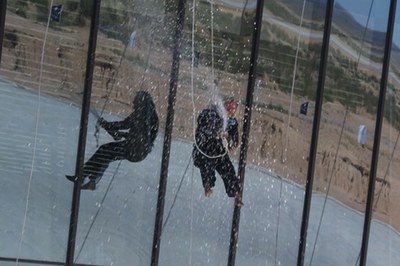 Sir Richard Branson, dangling on the side of the spaceport’s terminal building, sprays champagne on the crowd below as he announces the building’s name. (credit: J. Foust) |
Virgin’s progress towards spaceflight
Virgin Galactic didn’t use the event to make many major announcements about its plans, beyond the name of the terminal. Virgin did unveil some new research and education customers, including Space Florida, the state space agency, as well as the Challenger Center. The company also announced the hiring of the first of several pilots who will fly WK2 and SS2: Keith Colmer, a 22-year veteran Air Force pilot who was leaving the military to join Virgin.
Colmer said in an interview that he applied to be a NASA astronaut in the early 2000s and was a finalist for one of the Air Force slots but just missed the cut. He said he was looking forward to flying into space for Virgin. “Obviously it’s a little bit different business” than being a NASA astronaut, he said. “Test flying the vehicles into space is just going to be outstanding. I can’t wait.”
| “Our current aspiration is to try to get to some definition of space by the end of next year,” Whitesides said earlier in the month, with powered test flights to begin by the second quarter. |
Virgin did use the event to make the case that it is the leading company in the commercial suborbital sector, far ahead of its rivals. Company president and CEO George Whitesides discussed the progress the company has made since the last major event at the spaceport, the dedication of its runway almost exactly a year earlier. Those milestones include a series of glide flights, including several that tested the feathering mechanism critical for the vehicle’s stable reentry. The Spaceship Company (TSC), the joint venture of Virgin and Scaled Composites, has recently completed construction of a hangar at Mojave Air and Space Port in California where future WK2 and SS2 vehicles will be built, and assembly of the second set of vehicles is now underway, he said.
“There is no other company that is as close to flying people to space as Galactic,” claimed Whitesides. “There is no one else test flying vehicles that can take you and me into space. And there is no one whose vehicles are based on a design that has already been safely to space with people,” a reference to SS2′s precursor, SpaceShipOne.
Virgin Galactic has been stressing its maturity with some of its recent hires as well, including people with NASA experience. In addition to Whitesides, who rejoined Virgin last year after a stint as chief of staff to the NASA administrator, the company hired last month Steve Isakowitz as its executive vice president and chief technology officer. Isakowitz had worked at both NASA and the Office of Management and Budget and most recently as chief financial officer at the Department of Energy. And earlier this month Virgin hired Mike Moses, who has been launch integration manager at the Kennedy Space Center for the final shuttle missions, as its new vice president of operations. Moses, whose hiring was announced less than a week before the event, was already working for Virgin at the dedication.
While the company has made progress on staffing as well as lining up customers—it now has 455 “future tourist astronauts” signed up—the company still has work to do on the vehicle itself, including the rocket motor that will power SS2 on its suborbital spaceflights. “Our contractors are working hard now to get the system ready for the first powered flights next year,” Whitesides said at the event, noting they had carried out a 55-second test firing of the rocket motor in August and that another full-scale ground test is planned “very soon”.
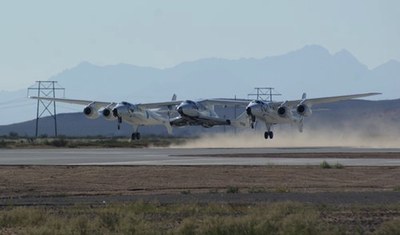 WhiteKnightTwo and SpaceShipTwo take off from Spaceport America on a brief demonstration flight. (credit: J. Foust) |
At another event earlier in October, Whitesides said Virgin planned to start powered flight tests early next year. “Our current aspiration is to try to get to some definition of space by the end of next year,” he said in a keynote address at the 100-Year Starship Study Symposium on October 1 in Orlando, being vague about what exactly “some definition of space” meant. Later last week, during a panel session of the International Symposium for Personal and Commercial Spaceflight (ISPCS) in Las Cruces, New Mexico, TSC chief engineer Scott Ostrem said they were hoping to begin powered flight tests by the second quarter of 2012.
There’s also the issue of SS2’s latest glide test, which took place on September 29 after a three-month hiatus. According to the official test log, SS2 “experienced a downward pitch rate that caused a stall of the tails,” forcing the pilots to activate the feather to restore control of the vehicle before gliding to a safe landing. There had been rumors, though, that the incident was more severe than the rather dry explanation in the log, with one observer telling SPACE.com that SS2 “dropped like a rock and went straight down” on that test flight.
At ISPCS last week, Ostrem provided his description of the test flight. “You come off the WhiteKnight and [are] quickly going into a pitch-down attitude by design,” he said. “We pitched down a little too steeply on that flight and experienced a tail stall.”
There are several options to recover from such a stall, he said, one of them being using the vehicle’s unique feathering mechanism, designed to provide stability during reentry. “Our pilot chose to feather it. It’s an incredible testament to the feather design: instantly the vehicle stabilized at about 20, 30,000 feet,” Ostrem said. “We just then de-feathered and glided back down safely. It was a unique opportunity for us to prove out the feather design at a point where we weren’t necessarily intending to do it.”
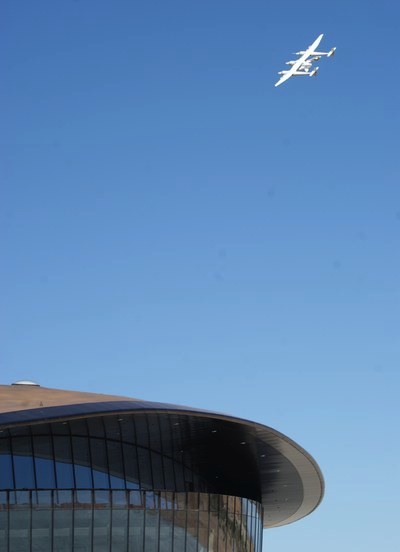 WhiteKnightTwo and SpaceShipTwo fly above Spaceport America’s terminal building during Monday’s dedication ceremony. (credit: J. Foust) |
Completing the spaceport
The fact that Virgin Galactic is still some time away from starting commercial flights at Spaceport America—Branson has indicated a desire to begin those flights by the end of 2012, which may be relatively optimistic given that the start of powered test flights is still several months in the future—is a mixed blessing for the spaceport. That schedule gives the New Mexico Spaceport Authority time to complete work on the facility. Although the terminal building was dedicated last Monday, it is not totally complete: peer through the glass wall and you see a bare interior; elsewhere, doors leading into the building are installed, but lacking handles.
| Spaceport America’s state support runs out when bonds expire at the end of 2013. “Starting January 2014 we have to be totally revenue supported,” Anderson said. |
“We have another eight weeks of mostly interior finishing” on the terminal building, said Christine Anderson, executive director of the spaceport authority, during an interview at the ISPCS last week. After that, Virgin will take over the fit out of the interior early next year. Workers are also wrapping up work on a smaller operations building at the spaceport that will house as well as utilities: just last week the spaceport got its permanent power line energized, after relying on generators for power since construction started in 2009.
Anderson said they’re already looking ahead to a second phase of construction, which will focus on paving a road leading to the spaceport from the south. For now, visitors to the spaceport from Las Cruces, El Paso, and other points to the south have to go all the way to the town of Truth of Consequences, 120 kilometers (75 miles) north of Las Cruces, then head east and south on paved roads to reach the spaceport. There is a shorter path, but on an unpaved road that is “very, very bumpy,” as she put it, making it accessible primarily only to four-wheel drive vehicles. Paving the road will be a two-year project, she said, including a year of environmental studies.
Another part of phase two will be the construction of two visitors centers for the spaceport along Interstate 25, one in the vicinity of Truth or Consequences and the other in the town of Hatch, about halfway between Truth or Consequences and Las Cruces. “We see it as an opportunity to inspire and educate,” she said of the centers. Placing the visitors centers along the highway, instead of at the spaceport itself, will make them more accessible to tourists driving by on the interstate, as well as ensuring security at the spaceport. (Buses will take visitors from the centers to the spaceport.)
While the state has some breathing room to finish the spaceport, they also don’t want Virgin to wait too long to start commercial operations there. Anderson said the bonds that funded the development of the spaceport, as well as the operations of the spaceport authority, expire at the end of 2013. “Starting January 2014 we have to be totally revenue supported,” she said. That revenue would come from lease payments from Virgin Galactic and other users of the spaceport as well as visitor center fees.
That transition presents a challenge to Anderson, one that she said she welcomes. “How do you go from totally state supported to a free enterprise model? There’s no book for that,” she said. Breaking new ground on that and other elements of developing and operating a new spaceport attracted her to the position early this year after a career as a civilian executive in the Air Force.
| “To see people there, and enjoying it,” Anderson said of the dedication event, “is just a little glimpse of what it’s going to be like in the future.” |
There’s also been a change of leadership in the state itself, as Bill Richardson, the governor who served as the patron of the spaceport project, left office; Susana Martinez, elected last November, took office at the beginning of the year. While originally portrayed as somewhat of a skeptic about the project, Anderson said the governor is “totally committed” to the spaceport. “I’m excited to have her in the leadership role in the state,” Anderson said.
Martinez was at the spaceport terminal building dedication last Monday and spoke about how the project can both generate jobs in the state, particularly high-tech ones, and provide a source of inspiration to the state’s youth. “As a young child, what could be more exciting than space travel?” she asked. “We want these new jobs to be created right here so that young New Mexicans don’t have to leave the state to find fulfilling work.”
“I look forward to strengthening the partnership between the state and Virgin Galactic,” she said at the dedication. Turning to Branson, she added, “And Richard, today I may have to add it to my bucket list.”
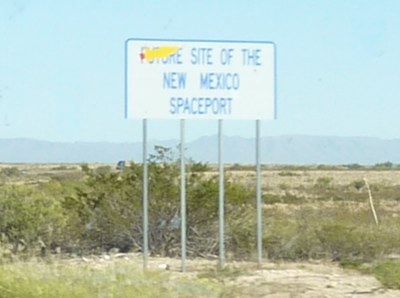 A sign on Interstate 25 announcing the “future” location of the spaceport, although via a road currently unpaved and difficult to traverse. (credit: J. Foust) |
Monday’s event provided Anderson with a vision of what the future might be like at the spaceport, with hundreds of people in attendance. “To see people there, and enjoying it,” she said, “is just a little glimpse of what it’s going to be like in the future.”
For some, that future has already arrived. At exit 32 on I-25, where the southern road—the one yet to be paved—meets the interstate, there’s a sign that reads “FUTURE SITE OF THE NEW MEXICO SPACEPORT.” On that sign someone has covered up the word “FUTURE” with an illustration of a rocket, with a yellow body and red flames coming out the bottom. However, for the spaceport, its anchor tenant, and even that road leading from the highway to the spaceport, the future is still a work in progress—and might be a little bumpy.
